
|

|

|
![]()

|

|

|
![]()
There are currently no sound demos of any Weltmeister keyboards displayed here. I am still researching this brand and it's various models and would be interested in acquiring a Weltmeister Basset/ComboBass and Claviset. It appears that Weltmeister manufactured both electric and electronic pianos, as well as an electric piano coupled with a Matador Combo Organ, and just for variety's sake I'm interested in all of these models. I've also confirmed that Weltmeister Claviset and Selmer Pianotron are virtually identical instruments, so I am placing them on the same page so they can be easely viewed and compared. There is a .wav sound file of the Pianotron pictured below, it may also be used as reference for Claviset sound.
Thank you,
lenny g
Weltmeister Basset a.k.a. Combo Bass |
|

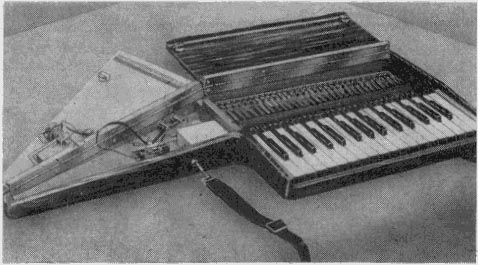



|
So let's say you are a keyboard player but your band needs someone to fill in on bass, you think you could go the Manzurek route and get a Fender Rhodes Piano Bass, but if you can't get one or think that the Rhodes is either too heavy, too big, too sparkly, or not sparkly enough, now there is an alternative. Presenting the original strap-on keyboard, the Weltmeister Basset, also known as Combo Bass, is a compact wearable bass keyboard based on the mechanical action of the Weltmeister Claviset. That's right, before Moog Liberation, before Roland SH-101, before MIDI keytars there was the Weltmeister Basset. In production 1963-1969 give or take a few years, features an 32 note F-C keyboard of those accordion type keys with rounded edges. It has electromagnetic pickups like it's big bother the Claviset. The "button" on the "neck" is a apperantly a volume control, and the whole thing runs on a 4.5V battery. Little else is known about this keyboard, but I'm still researching it. The b/w pics as well as the action diagram came from the Vermona web site. The pic of the "Combo Bass" model was found for sale in the Netherlands, and the other "unnamed" model is currently on display at the Synthorama Museum near Solothurn in Switzerland. |
Weltmeister Claviset Model ? |
|

|
This seems to be the earliest version of the Weltmeister Claviset found so far. The b/w pic came from a very strange German web site (dedicated to American country music and vintage East German equipment) called Black Roses. According to (my crude translation of) the German text on the referring website, this was the first electro-mechanical keyboard produced by Weltmeister. New it cost 1000 (East German Marks) and was available at least since 1963, but possibly even earlier. It utilized an action silmilar to that of the Hohner Cembalet using metal reeds, rubber plectrums, but the difference was in Weltmeister's electro-magnetic pickups. Volume was regulated with a knee lever, and later models also included adjustable tremolo. The Claviset also operated on a 4.5V battery. It sounded like a hard struck vibrophone. It is also suggested that later a two manual version was made combining the Claviset with a Matador combo organ. |
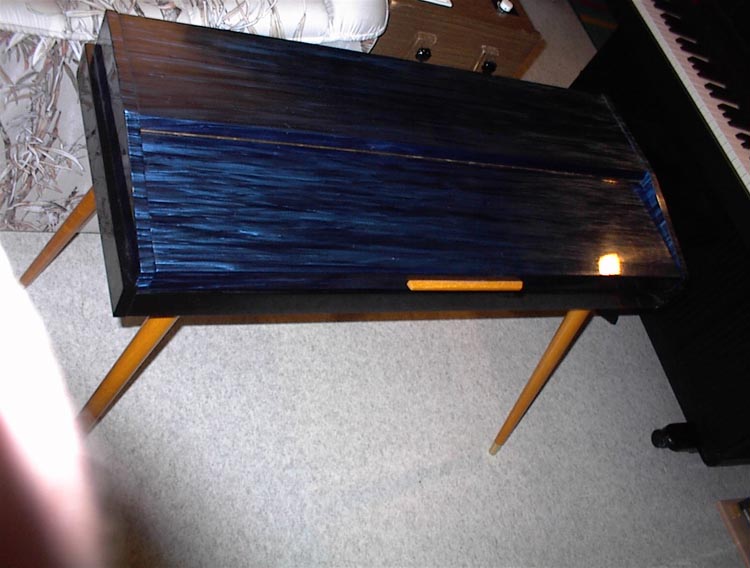
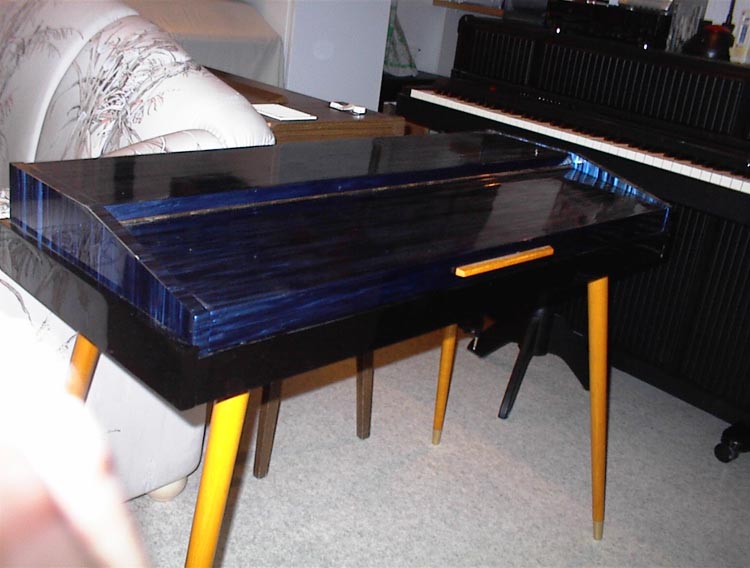
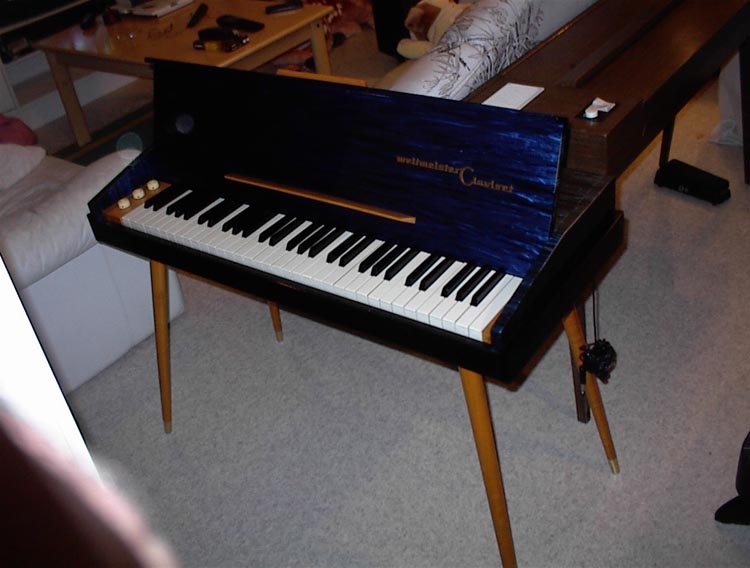
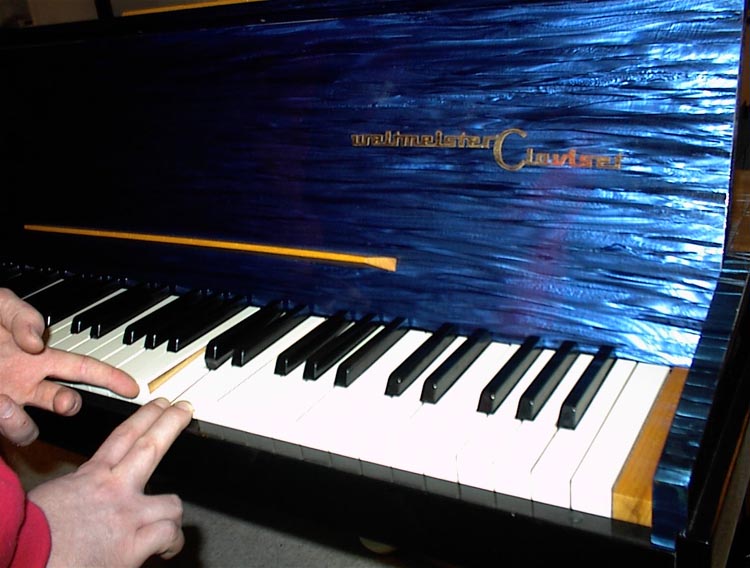


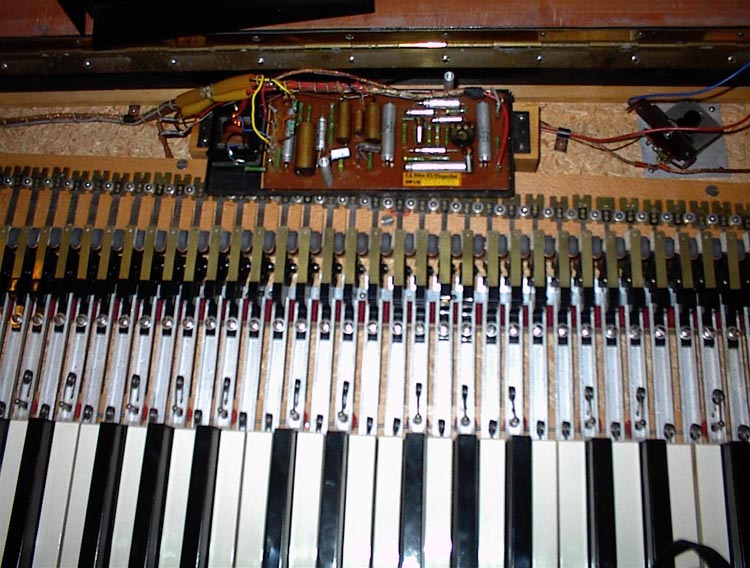
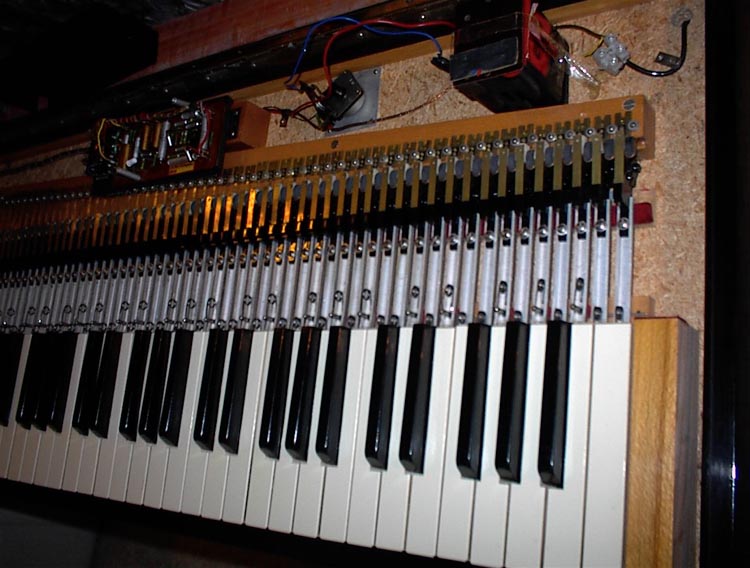
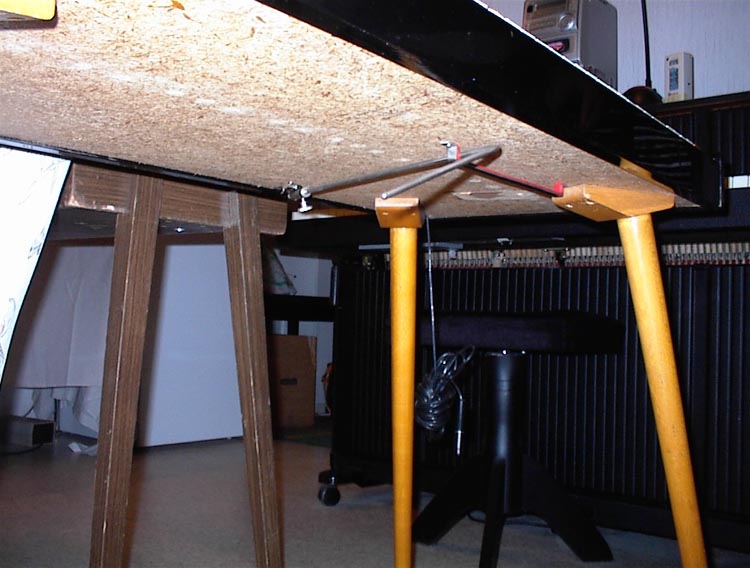
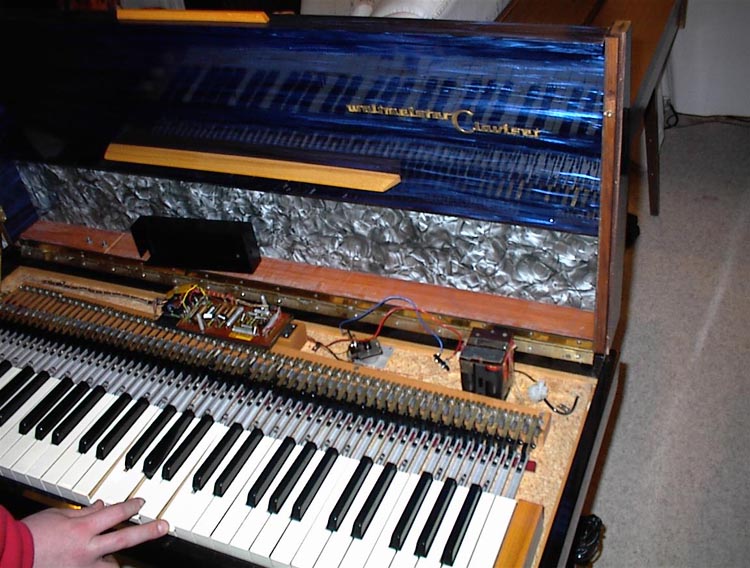

|
This beautiful Weltmeister Claviset appears to be the same model as above, but this one is presented here in all it's colorful splender and glory. It is owned by Dan Antone of Finland who was kind enough to provide these wonderful photographs for display on my site. In comparison to other electric pianos from around the world this one certainly would win the "Best Dressed" prize. And speaking of comparison, this model of Weltmeister Claviset appears to be almost identical to the Selmer Pianotron. Aside from their appearance the two instruments are virtually identical. The most probable reason for this is that Weltmeister manufactured all of these electric pianos, and Selmer imported and rebadged them for sale in the UK. The three knobs to the left of the keyboard are used to adjust tremolo speed/depth and bass boost, but according to Dan Antone, none of the controls really make a noticeable difference in sound. I assume the bass boost is a passive circuit just like the Rhodes Bass Boost control. Volume is adjusted on the bottom of the piano with a knee lever that can be folded up for storage and transport. One very destinctive feature of the Claviset is that it has wooden keys, as opposed to Hohner keyboards that have plastic keys. Despite that supposed advantage, Dan Antone says of its playability: “I don’t like the action of the Claviset. It doesn’t have any kind of dynamics. No matter how hard you hit, or how softly you press, it will always play at the same volume”. Words reminiscent of those coming from Hohner Pianet and Cembalet players. Although in my opinion, and I'm sure Dan Antone would agree, what it lacks in function, it certainly makes up for in it's funky appearance. I would be glad to share any stage with one of these wonderful keyboards anywhere anytime. |
Weltmeister Claviset Model 300 ? |
|

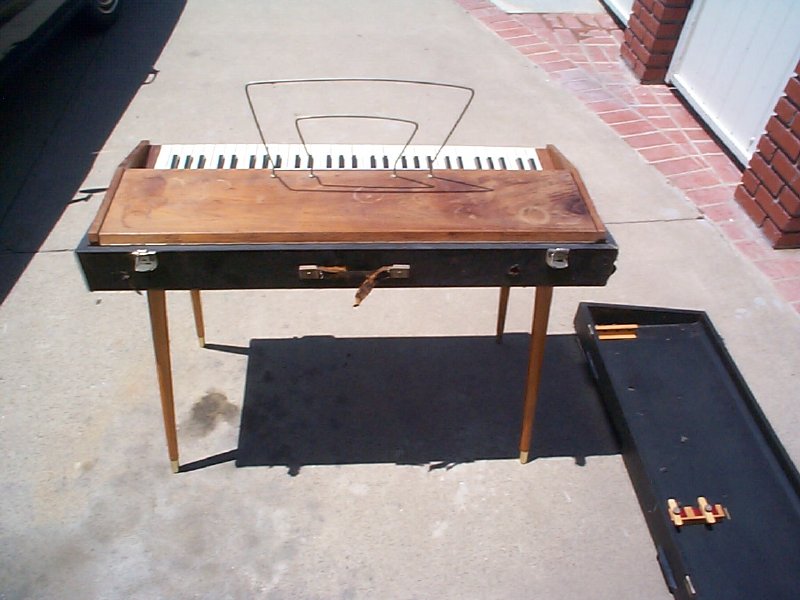
|
This unlabeled model of Weltmeister Claviset was found for sale in the Recycler by my friend Les, however it is possible that this is model 300 which does not have any controls. The seller had it listed as "Hohner Pianet", so in our infinite wisdom we contacted the seller and told him that a Pianet has an F-F keyboard, but his is a C-C keyboard, so it is not a Pianet but a Cembalet. Then Les and I wondered how this supposed Hohner Cembalet ended up with a very distinct Weltmeister music rest, and then it hit us, DUH! Shortly after Simon found those East German sites with other Weltmeister Claviset pictures and it was confirmed, a Weltmeister Claviset found all the way in Los Angeles. I begged and pleaded with the seller to sell it to me, but he refused to ship it, and I could not drive from Ohio to California and back just to pick it up in person. I certainly hope I come across another one of these sometime. Unfortunatelly, I don't have any info about this model, but it appears to be a very basic version, no controls, there may be a volume lever underneath. It does not have the same pearloid finish as it's predecessor, and the Tolex covered outer case suggests that perhaps this was a stage model, designed to withstand the constant travel and sometimes abuse of a working musician. |
Weltmeister Claviset Model 200 |
|

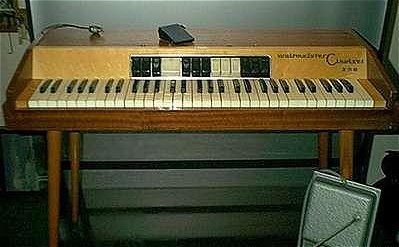
|
These two pics are from the Vermona web site. The model 200 has those oddly shaped tablet-like controls which I believe are similar to the "preset EQ/filter tabs" on the Hohner Clavinet. The nine tone tabs are: Bass, Guitar, Tutti, Piano, Harp, Celeste, Music Box, Metallophone, and Xylophone, the remaining 3 tabs are for selecting vibrato settings. I think the names of the switches represent the tonal qualities of the sound filters they engage, and do not refer to electronic instrument emulations. This is also the only electric piano of this kind to appear with not one, but two pedals. Perhaps Weltmeister found a way to implement sustain on plectrum based action, or redesigned it's action to be more like that of a Wurlitzer electric piano. If you look closely at the pedals, you'll notice that the pedal on the right has the cable protruding from the top of the pedal case like a Wurlitzer EP sustain pedal, while the left pedal has the cable going to the back of the case, like an electronic footswitch. This is also very similar to the pedal system employed in the Hohner Electra-Piano. Any of these options are possible, but this will remain a mystery until someone can cofirm one of these theories. |
Selmer Pianotron |
|
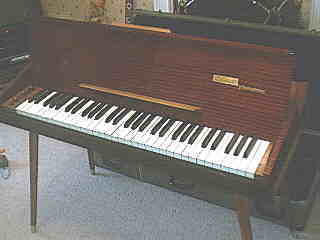
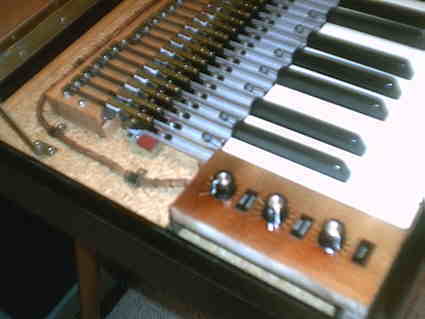
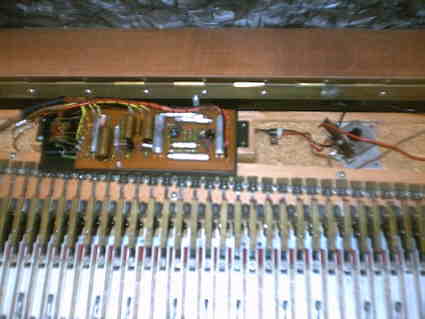
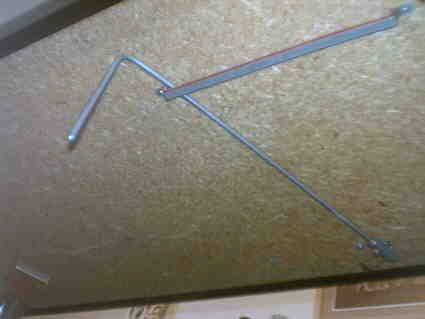

|
Selmer Pianotron (.wav sound file - 1.4MB - 1:32) Pictures and sound recording are contributed by Steve Howe of London, England. Selmer Pianotron appears to be the same instrument as the Weltmeister Claviset. I beleive that Weltmeister manufactured all of these pianos, and Selmer rebadged them for sale in the UK. Please refer to the Claviset for a more detailed description of the mechanical and electrical components. |

|

|

|